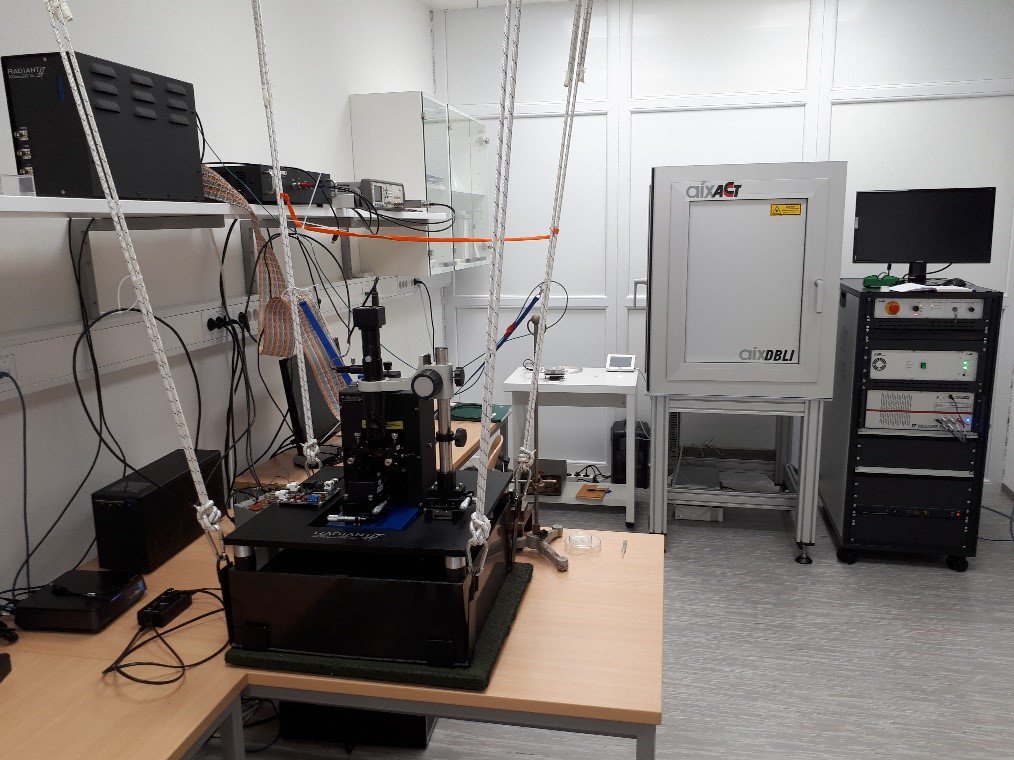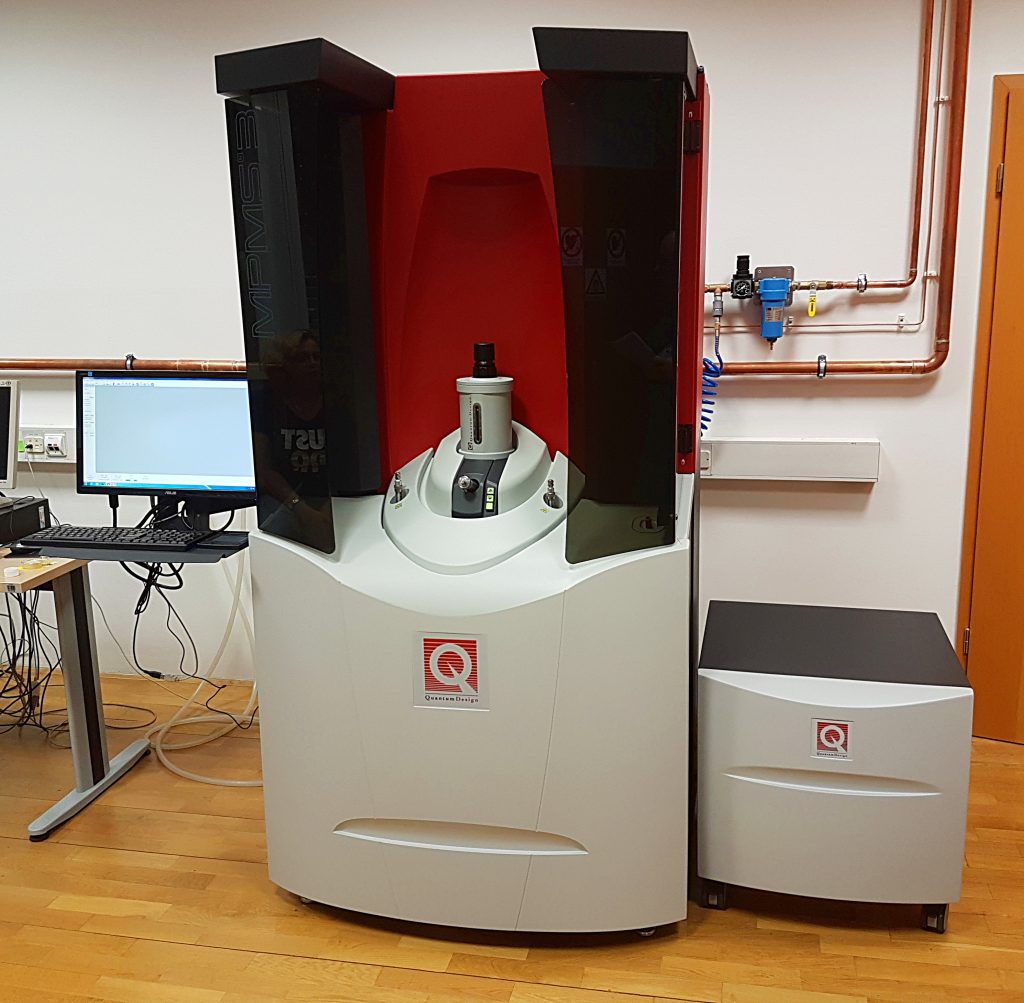Physics of quantum and functional materials
- About research group
- Members
- Equipment
Head: Prof. Denis Arčon, PhD
Code: P1-0125
Duration: January 1, 2022–December 31, 2024
Although quantum effects have been exploited in a wide range of electronic devices for a long time, the past decade has seen a dramatic improvement in our understanding of how subtle quantum effects control macroscopic behaviour of a whole range of materials with different functionalities. The research programme “P1-0125: Physics of quantum and functional materials” will investigate fundamental physical phenomena in such materials and explore the possibility of emerging applications.
The research programme brings together a broad and complementary expertise of a large group of condensed-matter physicists with a prominent track-record in the field proved by numerous highly-cited publications in high-profile international journals (e.g., Science and Nature series), by various national and international awards, plenary and invited talks at the most prestigious international conferences, as well as by international patents. The focus of the research programme will be around two strongly interlinked directions: materials and related technologies.
Our main aim will be to deepen the understanding of (i) the quantum entanglement phenomena in materials, (ii) the topological properties and their effect on the ordered states, (iii) the new quasiparticles predicted in low-dimensional quantum materials, (iv) the role of defects in stabilizing the quantum order, (v) the role of electron correlations in fuelling the competition between various types of quantum order, and (vi) the coupling of different degrees of freedom in order to take advantage of the (multi)functional behaviour, such as found in multiferroics and electrocalorics.
These phenomena will be investigated (i) in carefully selected families of quantum materials exhibiting unconventional superconductivity, quantum magnetism or exotic quantum spin-liquid ground states, (ii) in a range of topological materials, such as those with magnetic skyrmions, (iii) in multicaloric and multiferroic materials, and (iv) in high-entropy alloys.
The research group will use a broad arsenal of experimental techniques available at the home institution, such as the magnetic resonance and dielectric spectroscopy, thermal and magnetic property measurements, as well as other techniques available at various large-scale user facilities, such as the neutron scattering and the muon spectroscopy. Novel techniques will also be developed to address quantum and functional phenomena over the broad energy, length and time scales. Our experimental findings will not only be compared to the paradigmatic theoretical models, but will also stimulate the research of several potential applications. In particular, we will develop a novel highly sensitive optical magnetometer method challenging the current limitations in sensitivity, we will propose new methods for quantum computing using magnetic resonance techniques, and we will explore novel functionalised materials for 3D printing beyond the current state-of-the-art.
| Name and surname | Role | Laboratory | Room number |
|---|---|---|---|
Denis Arčon | Head of the research group | Pulse EPR laboratory | 022A |
| Tomaž Apih | Researcher | Relaxometry laboratory | 20 |
| Tina Arh | Young Researcher | ||
| Franci Bajd | Researcher | ||
| Izidor Benedičič | Researcher | ||
| Vid Bobnar | Researcher | Relaxometry laboratory | |
| Janez Dolinšek | Researcher | NMR laboratory | |
| Darja Gačnik | Researcher | ||
| Matjaž Gomilšek | Researcher | ||
| Katja Gosar | Young Researcher | ||
| Žiga Gosar | Young Researcher | ||
| Anton Gradišek | Researcher | ||
| Alan Gregorovič | Researcher | NMR laboratory | |
| Youness Hadouch | Researcher | ||
| Anton Hromov | Young Researcher | ||
| Dražen Ivanov | Technician | ||
| Peter Jeglič | Researcher | NMR laboratory | |
| Andreja Jelen | Researcher | ||
| Vida Jurečič | Young Researcher | ||
| Martin Klanjšek | Researcher | NMR laboratory | |
| Tilen Knaflič | Researcher | ||
| Georgios Kordogiannis | Researcher | ||
| Primož Koželj | Researcher | ||
| Zdravko Kutnjak | Researcher | Relaxometry laboratory | |
| Marta Lavrič | Researcher | ||
| Jože Luzar | Researcher | ||
| Bojan Marin | Researcher | ||
| Aleksander Matavž | Researcher | ||
| Maj Mejak | Young Researcher | ||
| Tadej Mežnaršič | Researcher | ||
| Peter Mihor | Technician | ||
| Matic Morgan | Young Researcher | ||
| Nikola Novak | Researcher | ||
| Julia Petrović | Young Researcher | ||
| Jure Pirman | Young Researcher | ||
| Dušan Ponikvar | Researcher | ||
| Matej Pregelj | Researcher | Pulse EPR laboratory | 022A |
| Anna Razumnaya | Researcher | ||
| Andraž Rešetič | Researcher | ||
| Brigita Rožič | Researcher | ||
| Yuliia Shyshkina | Researcher | ||
| Yuri Tanuma | Visiting Researcher | ||
| Polona Umek | Researcher | Chemical synthesis laboratory | 104 |
| Stanislav Vrtnik | Researcher | NMR laboratory | 17 |
| Magdalena Wencka | Visiting Researcher | ||
| Aleksander Zidanšek | Researcher | ||
| Andrej Zorko | Researcher | Pulse EPR laboratory | 022A |
Double beam laser interferometer
Description
The double beam laser interferometer (DBLI) is used for parallel measurement of electromechanical and electrical properties of thin dielectric layers in nanostructured materials. The laser beam hits the sample from above and from below at the same time (differential measurement principle), eliminating the influence of sample bending. The system can be used for (i) parallel measurement of electromechanical expansion and electric polarization at large excitation signal, (ii) measurement of piezoelectric coefficient and dielectric constant at low excitation signal, even when dc voltage is applied, and (iii) measurement of strain on electric and electromechanical properties. The system resolution is 0.5 pm and enables measurement of all the listed quantities in the -100°C to 300°C temperature range.
Access to equipment
To use the equipment, please contact dr. Vid Bobnar (vid.bobnar@ijs.si). The measurements are executed by our researchers, who are have been trained to use the DBLI. External users can bring the samples and participate in the measurements.
Price
The price for an hour of the DBLI use is EUR 100. This includes electricity, consumables and execution of measurements by researchers in dr. Bobnar’s research group.

SQUID magnetometer Quantum Design MPMS3
Description
In 2016, a new QD-MPMS3-VSM magnetometer by American manufacturer Quantum Design was installed and commissioned at the JSI. The basis of this magnetometer is a SQUID detector which allow the device to be used as a classical magnetometer or as a VSM (vibrating sample magnetometer). It can be used to measure DC magnetization, AC magnetization, M(H) magnetization curves, and long-time decay of thermoremanent magnetization on long time scales. The magnetometer uses a superconducting magnet with variable magnetic field of ± 7 Tesla, the temperature range of measurements is between 1.8 K and 400 K or between 280 K and 1000 K when an oven is used. The alternating susceptibility can be measured in the frequency range between 0,001 Hz and 1500 Hz. External magnetic field (e.g. geomagnetic field) can be reduced to as little as 0.1 gauss at the sample location. The measurements can be performed under hydrostatic pressure in the range between 0 to 1.3 GPa.
Access to equipment
To use the equipment, please contact prof. dr. Janez Dolinšek (jani.dolinsek@ijs.si) at JSI. The measurements are executed by our researchers, who are have been trained to use the MPMS3 magnetometer (members of prof. Dolinšek’s research group). External users can bring the samples and participate in the measurements.
Price
The price for an hour of magnetometer use is EUR 120. This includes electricity, the necessary liquid helium and execution of measurements by researchers in prof. Dolinšek’s research group.

